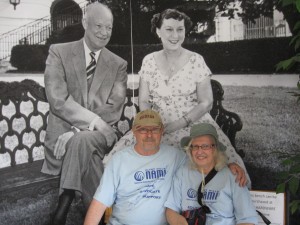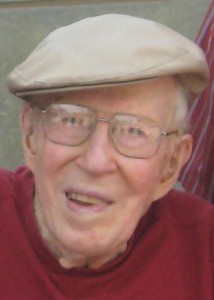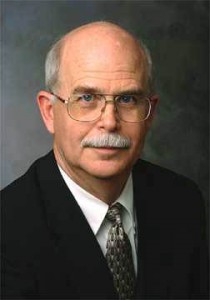David Kromm:
A quieter year than many, as Bobbie and I try to age gracefully and celebrate holidays and family events. Highl ights were Easter with son Chris and his family in North Carolina, graduation day with granddaughter Emma in Massachusetts, and Bobbie’s family reunion in Pennsylvania. Nearer home we sat with another Kansas couple at the annual Kansas Sampler Festival, which was held in Wamego.
ights were Easter with son Chris and his family in North Carolina, graduation day with granddaughter Emma in Massachusetts, and Bobbie’s family reunion in Pennsylvania. Nearer home we sat with another Kansas couple at the annual Kansas Sampler Festival, which was held in Wamego.
Stephen L. Stover:
My annual report for the year just past looks much like my other reports in recent years with one major exception:
I spent many hours studying my collection of 35 mm slides not from January 2015 but from January 1st, 1950. I was joined in weekly meetings by geography graduate student Rob Briwa who, after placing slides on my manual projector, entered with me into “who-what-when-where” detective work to describe and label each one. Some slides were of home and family, some  of journeyed landscapes.
of journeyed landscapes.
By arrangement with KSU Geography Department, my family, and KSU Libraries, all 16, 500 labeled slides are part of the Stephen L. and Enid Stover Papers, available at the Morse Department of Special Collections at Kansas State University Libraries. Selected slides will be digitized to become accessible to a wider public in the internet community – and they will be contributive to a developing field of research called the digital humanities.
A symposium on digital humanities was held in February to explore research in this field. My scholar daughters Merrily Stover and Sue Stover worked with Mr. Briwa and K-State archivist Cliff Hight to offer the symposium a report on our collaboration. We were a case study of the potential for using slides as a rich resource for interdisciplinary digital humanities research.
Mr. Briwa suggests that the report was well-received overall. In fact, our weekly collaboration was seen as a model of “participatory archives” – an emerging form of archival work which showcases the potential for collaboration between archives, subject specialists, and family.
Other scholars presented papers and projects to explain how their personal research contributes to digital humanities scholarship. These papers and personal contacts are expected to enhance understanding of those like me who may continue to need help in understanding how these new technical procedures add to our knowledge of the world.
An example of how my slides may contribute to research came from a family member who noted floral print pants in family photos from 1970s. From the recognition that these styles are now coming back in current fashions reveals a general principle relevant for potential scholars: after major changes, everything comes back around and can be studied in a field of research.
Mr. Briwa suggest that altogether with technology the photographs could be used to support instruction and research topics in agriculture, economics, home economics, anthropology, sociology, science education, history and geology among other fields. What a wide range of humanity these 35mm slides could reach!
At the time of this report, our collaborative labeling process is 30% complete, with about 25% of selected slides already digitized. When all is said and done, I’ll be curious to see if Rob is right!
Steven L. Stover with Rob Briwa
Stephen E. White: 1947 – 2015
Received his bachelor’s degree in 1969, master’s degree in 1972, and his doctorate in 1974 from the University of Kentucky. He joined K-State in 1975 as an assistant professor of geogr aphy.
aphy.
Steve White was Dean of the College of Arts and Sciences and professor of geography at KSU. He also served as head of the department of geography for 12 years and an Associate Dena for four years. He authored or co-authored 75 articles and book chapters and made 125 professional presentations on topics related to migration, population change and economic development in Appalachia as well as on demographic and groundwater issues in the American High Plains.
In 1991, White received the Distinguished Teaching Achievement Award for Excellence in Geography from the National Council for Geographic Education. He also received the Conoco Outstanding Undergraduate Teaching Award at K-State in 1988, and the William L. Stamey teaching award in 1989. In 2001, he received the John Fraser Hart Award for Research Excellence from the Contemporary Agriculture and Rural Land Use Specialty Group of the Association of American Geographers. His research has been funded by the National Science Foundation and the Department of Energy’s National Institutes for Global Environmental Change as well as many other sponsors.
Stephen E. White passed away Saturday March 21, 2015 – he will be sorely missed.
The White family invites you to the Steve White Memorial Celebration.
* Date: Sunday, April 19
* Time: 5:30-7:30 PM
* Location: The Flint Hills Discovery Center, 315 S 3rd St, Manhattan, KS.
For those of you who wish to honor Steve, the White family suggests contributions to the following charities:
http://www.ymlfuneralhome.com/obituary/5419
- The White Geography GTA Excellence Award – designed to help deserving students attend professional meetings and job fares. You can donate through the KSU foundation, Fund Option: Q95152. https://one.found.ksu.edu/ccon/new_gift.do?action=newGift&scenario=selectfund&reason=WEB.
- The Alzheimers Research Foundation (alzinfo.org). https://www.alzinfo.org/donate/donation_form/
Glad to receive the newsletter. I enjoy reading about fellow Geographers and where the staff and department is headed. My wife & son are doing great. My son is now 6 years and made his first snowman this Winter with a unusual amount of snowfall for our area of Texas. We did a little traveling to the coastline of Texas at Corpus Christi last year.
Steve was a strong supporter of education. His contributions to geography are greatly appreciated by his colleagues and friends.
My heart is with you all.